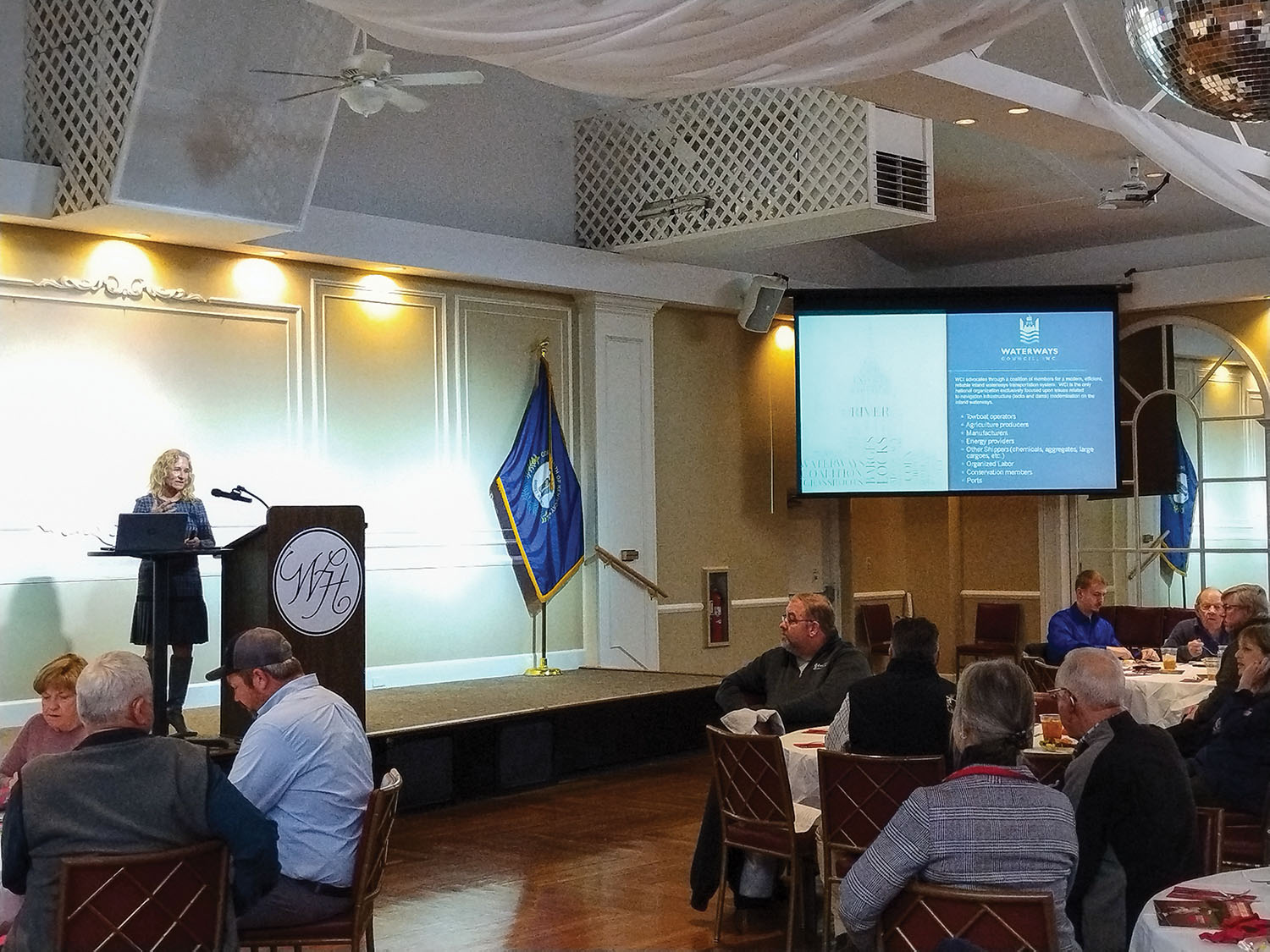The Port of Paducah Propeller Club has a new monthly schedule for 2024.
Thanks to some corporate sponsorships, the club will now hold lunch meetings at noon the second Wednesday of the month at Walker Hall, 229 Madison St. No monthly meetings will be held in May, July or December, when the club hosts its golf scramble, baseball game social and river industry Christmas event.
Deb Calhoun, senior vice president of Waterways Council Inc. (WCI), kicked off the new schedule as the guest speaker January 10.
Calhoun spoke about WCI’s mission as an advocacy organization for the inland waterways, bringing attention to the system’s infrastructure needs and working toward policies that benefit the system and its users.
“The challenge for Waterways Council Inc. and for the nation is our antiquated lock and dam system,” she said, pointing to a graph that showed more than 80 percent of the country’s operational lock chambers are more than 50 years old.
Calhoun noted that partly as a result of WCI’s work, appropriations for the system have increased from $4.86 billion in Fiscal Year 2011 to $9.57 billion expected for Fiscal Year 2024, although the FY24 Energy and Water Development Appropriations bill had not yet been passed at press time.
While noting that the country is again facing a possible government shutdown due to lack of congressional agreement on a spending bill, Calhoun said it is difficult to get Congress to compromise to reach important funding measures.
Despite that, however, she said infrastructure spending for the inland waterways generally enjoys bipartisan support.
In 2024, WCI is focusing a great deal of attention on passing the biennial Water Resources Development Act (WRDA). WCI’s biggest priority for WRDA 2024 is for Congress to agree to fund seven major construction and rehabilitation projects to completion at 100 percent federal cost—as originally intended in the Infrastructure Investment and Jobs Act (IIJA)—vs. the current 65 percent federal/35 percent Inland Waterways Trust Fund cost-share formula in place for the rest of the navigation projects under construction.
An example of one of those projects that was previously believed to be funded to completion in IIJA is the Kentucky Lock Addition Project. Because of inflation, supply chain shortages and workforce shortages associated with COVID-19, the remaining cost to complete the project is $332 million, Calhoun said the Corps of Engineers has estimated.
The project, which will build a 1,200-foot lock adjacent to the existing 600-foot lock at Tennessee River Mile 22.4 in western Kentucky, was authorized by Congress in 1996. It is now expected to be operational in 2029 and fully completed in 2030.
When complete, the wait time at the lock should decrease from more than 10 hours to no waiting, she said, providing a great gain in efficiency for shippers and operators.
Construction began on the existing lock in 1938, and it was operational in 1944.
Calhoun noted that the 12,000 miles of the inland waterways system touch 28 states and include 219 locks at 176 sites but added that it has been important to educate legislators on its benefits, including how it affects agriculture exports in faraway areas.
Nearly 500 million annual tons valued at more than $150 billion move on the system, with 65 percent of grain exports transported by river, she said. She added that as many as 540,000 jobs depend on the river system.
Pointing to information from a new profile of Kentucky released by the National Waterways Foundation, she said nearly 158,000 of those jobs are in Kentucky, with the majority in and immediately surrounding Paducah.
Kentucky has nearly 1,590 miles of navigable inland waterways, the fourth highest in the country, according to the NWF profile data.
Calhoun also addressed recent historic low-water conditions on the waterways, noting that while the last two years have seen record low-water conditions in parts of the mid and Lower Mississippi Valley regions, the last previous systemwide low-water conditions took place in 2017. In all cases, she said, products have been delivered despite difficult conditions, although some shipments were delayed.
She spoke about the importance of construction of new dredges and the recapitalization of the Corps of Engineers’ dredge operations as important in responding to such weather events.
While water transportation may not be as quick as some other modes, Calhoun stressed that it is cheaper, greener and safer.
One 15-barge tow moves the equivalent of 216 rail cars plus six locomotives or 1,050 tractor-trailer rigs, she said.
In looking at fuel efficiency, one barge can move 675 ton-miles per gallon of fuel, compared to 472 via rail and 151 per truck.
Finally, she said, for every one injury in the river industry, there are 96 in the rail industry and 1,145 injuries on tractor-trailer rigs.
The next Port of Paducah Propeller Club meeting will be February 14, with the guest speaker from Healthworx speaking about drug testing.
Caption for photo: Deb Calhoun, senior vice president of Waterways Council Inc., speaks at the January 10 meeting of the Port of Paducah Propeller Club at Walker Hall in Paducah, Ky. (Photo by Shelley Byrne)




